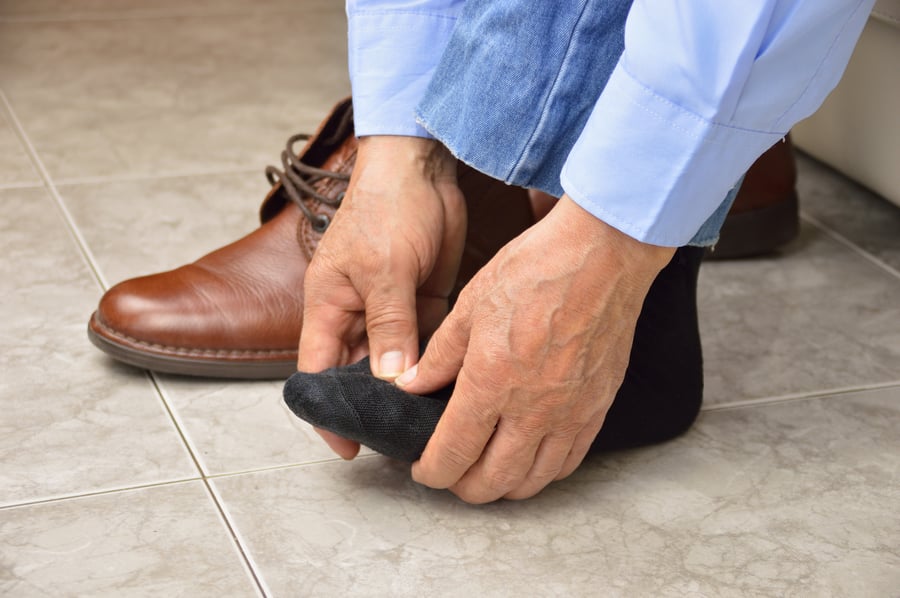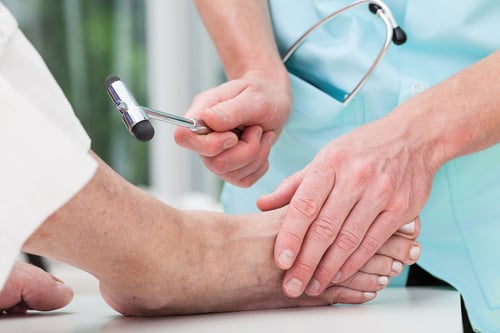
Arthritis is a common condition that affects millions of people worldwide, causing pain, stiffness, and reduced mobility. While many associate arthritis with hands and knees, it can also significantly impact the foot and ankle.
It’s a health issue that will continue to become more prominent as America’s nearly 70 million Baby Boomer generation moves into their retirement years and beyond.
“They danced to the Beatles, the Rolling Stones and disco. They worked out with Jane Fonda and made jogging their national pastime,” says The American College of Foot and Ankle Surgeons Foot Health Facts. “Now approaching retirement, many members of the "Me Generation" aren't ready to slow down, even if their bodies are. Foot and ankle surgeons say Baby Boomers are more likely than previous generations to seek care when arthritis develops in their toes, feet and ankles.”
At Sweeney Foot & Ankle Specialists, we understand the challenges that foot and ankle arthritis can present to our patients of all ages in The Woodlands and Magnolia areas of Greater Houston, Texas.
This comprehensive guide will explore the nature of arthritis, its specific effects on the foot and ankle, symptoms to watch for, and various treatment options available.
What is Arthritis?
Arthritis is a general term for joint inflammation, encompassing over 100 different types of joint diseases.
In essence, arthritis causes the breakdown of cartilage - the smooth, cushioning tissue that protects the ends of bones where they meet to form joints. As this protective layer deteriorates, bones can rub against each other, leading to pain, stiffness, and decreased range of motion.
“Knees, elbows, fingers, wrists, ankles—your body is full of places where your bones connect to one another. And at these intersections, just like the ones on the road, things can go wrong, from injury to arthritis or other diseases,” says Johns Hopkins Medicine.
The two most common types of arthritis affecting the foot and ankle are:
- Osteoarthritis: Often referred to as "wear-and-tear" arthritis, this type occurs as cartilage breaks down over time due to age or overuse.
- Rheumatoid Arthritis: An autoimmune disorder where the body's immune system attacks the joint lining, causing inflammation and damage.
- Gout: A type of arthritis caused by a buildup of uric acid crystals in the joints.
How Arthritis Affects the Foot and Ankle
The foot and ankle are complex structures, containing 26 bones, 33 joints, and more than 100 muscles, tendons, and ligament that all work together to bear weight, allow for locomotion, and transmit force.
This intricate anatomy makes these areas particularly susceptible to arthritis. Common sites for foot and ankle arthritis include:
- The ankle joint
- The hindfoot joints (where the heel bone connects to the ankle)
- The midfoot joints
- The big toe joint
When arthritis develops in these areas, it can significantly impact a person's ability to walk, stand, or perform daily activities comfortably.
“Baby Boomers are most likely to develop osteoarthritis in their big toe joint. During walking, the big toe absorbs forces equal to nearly twice a person's body weight. It plays an important role in stooping and standing. Some boomers start to develop big toe stiffness, a condition called hallux limitus, in their forties,” says the American College of Foot and Ankle Surgeons.“Ankles are another prime spot for arthritis. Ankles are more likely to develop posttraumatic arthritis than osteoarthritis. For many Baby Boomers, the trauma was an ankle fracture or a bad sprain that may have happened in their teens or twenties.”
Symptoms of Foot and Ankle Arthritis
Recognizing the symptoms of foot and ankle arthritis is crucial for early diagnosis and treatment. Common signs include:
- Pain: Often described as a dull, aching sensation that worsens with activity or after periods of rest.
- Stiffness: Particularly noticeable in the morning or after sitting for extended periods.
- Swelling: The affected joint may appear puffy or feel warm to the touch.
- Reduced range of motion: Difficulty moving the foot or ankle through its full range of motion.
- Changes in gait: Limping or changes in walking pattern to avoid pain.
- Difficulty with certain activities: Trouble with stairs, walking on uneven surfaces, or wearing certain shoes.
If you're experiencing any of these symptoms, it's essential to consult with a foot and ankle specialist for a proper diagnosis.
“Joint swelling, redness in the area, or a section of skin that unusually warm to the touch are all signs of inflammation that could be due to arthritis, infection or another cause,” says Johns Hopkins rheumatologist Rebecca Manno, M.D., M.H.S. “Many people feel a little stiff in the morning as they get older. If it lasts less than 30 minutes and eases as you get moving, that’s not too worrisome. But if it doesn’t disappear until after lunch or later, that’s a sign there’s something more going on.”
Diagnosis of Foot and Ankle Arthritis
Accurate diagnosis is crucial for effective treatment of foot and ankle arthritis. At Sweeney Foot & Ankle Specialists, we employ a comprehensive approach to diagnosing arthritis, which typically includes:
Medical History and Physical Examination
Your doctor will begin by discussing your symptoms, medical history, and any previous injuries. They will then conduct a thorough physical examination, looking for:
- Swelling, redness, or warmth in the affected joints.
- Range of motion limitations.
- Areas of tenderness.
- Changes in foot shape or alignment.
- Calluses or other skin changes that may indicate abnormal pressure points.
Gait Analysis
Observing how you walk can provide valuable information about the severity and location of arthritis. Your doctor will assess your stride, foot alignment, and any compensatory movements you may have developed.
Imaging Studies
Various imaging techniques are used to confirm the diagnosis and assess the extent of joint damage:
- X-rays: These are the primary imaging tool for diagnosing arthritis. Weight-bearing X-rays are particularly useful as they show the joints under normal stress.
- CT scans: For more detailed images of bone structures, especially in complex cases.
- MRI scans: These provide detailed images of soft tissues, helping to assess cartilage damage and inflammation.
Referral to a Rheumatologist
In some cases, your doctor may refer you to a rheumatologist to help determine the type of arthritis and rule out other conditions, especially for diagnosing inflammatory types of arthritis like rheumatoid arthritis.
Specialized Tests
For complex cases, additional tests may be necessary:
- Bone scans: To detect areas of increased bone metabolism, which can indicate arthritis.
- Arthroscopy: A minimally invasive procedure that allows direct visualization of the joint interior.
By combining these diagnostic methods, our specialists can accurately determine the type and extent of your arthritis, enabling us to develop the most effective treatment plan for your specific condition.
Treatment Options for Foot and Ankle Arthritis
At Sweeney Foot & Ankle Specialists, we offer a range of treatment options tailored to each patient's specific needs and the severity of their condition. Treatment approaches typically include:
Conservative Treatments
- Physical Therapy: Targeted exercises can help improve flexibility, strength, and range of motion in the affected joints.
- Medications: Over-the-counter anti-inflammatory drugs or prescription medications can help manage pain and reduce inflammation.
- Orthotics and Supportive Footwear: Custom orthotics or specially designed shoes can provide support and relieve pressure on arthritic joints.
- Injections: Corticosteroid injections can offer temporary relief from pain and inflammation in affected joints.
- Weight Management: Maintaining a healthy weight reduces stress on the foot and ankle joints.
Advanced Treatments
For more severe cases or when conservative treatments don't provide adequate relief, we may recommend:
- Minimally Invasive Procedures: Arthroscopic surgery can be used to remove damaged cartilage or bone spurs.
- Joint Fusion: In advanced cases, fusing the affected joint can provide long-term pain relief and stability.
When to Seek Professional Help
If you're experiencing persistent foot or ankle pain, stiffness, or swelling, it's crucial to seek professional evaluation.
Early diagnosis and treatment can significantly improve outcomes and prevent further joint damage.
At Sweeney Foot & Ankle Specialists, our team of expert podiatrists specializes in the diagnosis and treatment of foot and ankle arthritis. We utilize state-of-the-art technology and personalized treatment plans to help our patients in The Woodlands and Magnolia areas achieve optimal foot and ankle health.
Contact Sweeney Foot & Ankle Specialists today to schedule a comprehensive evaluation and take the first step towards a more pain-free living.






